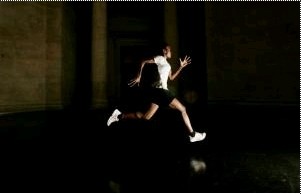Thirty five Irish athletes are entered to compete in this year's European Masters or Veterans track and field championships in Slovenia. The 10k will kick off the games on Thursday 24th July and the events will continue right through until Sunday 3rd August with the marathon and relays.
Martin McEvilly, GCH, a previous gold medal winner at the World championships in the M55 Steeplechase, is entered for the 5k, 10k, and the Steeplechase. Having just in the last two weeks celebrated his 60th birthday, Martin is hopefully poised to add to his medal collection.
You can follow the games at http://www.evacs2008.si/?stran=home.
For no particular reason, I include this critique in The Independent of an Art event at the London Tate gallery. Think of it when you set off at 9:04 in the rain next Saturday morning from the church car park in Athenry...think Art.
The accompanying graphic is a photo from the exhibition.
Coming across Martin Creed's Work No. 850 at Tate Britain, your first response is, naturally, surprise, with a slight added frisson of danger. You're in a museum. This means a social rule is being broken.
As you may have heard, the Turner Prize-winning artist has arranged for relays of young runners, male and female, to pelt every 30 seconds, one at a time, as fast as possible, from one end of the central Duveen Gallery to the other, while avoiding visitors. Since the stretch is only 87 metres, there's a pause before the next sprinter appears. And, on weekdays, when there aren't many visitors, they have a straight-ish run.
If this was happening on a track or in a park, you probably wouldn't give it much refection. But it's happening in an art gallery, and so – beyond being surprised – it's right to apply some artistic considerations, and see if they're rewarded.
For example, you can pay attention to the work's structure. You can notice that Work No. 850 involves fixed start- and end-points, and fixed time intervals, and maximum speed – but also a variable path between these points (depending on interposing visitors) and variable pauses between each run (depending on individual speeds). And, if you're critically inclined, you can wonder whether this is a satisfying structure. Do the 30-second intervals set up a good rhythm? Would it be improved by slower speeds? Would a marked-out visitor-free path be better? How about just a single runner? Or, even if the arrangement is as good as it can be, does this very minimally shaped experience amount to all that much?

